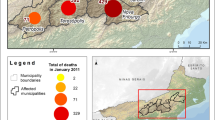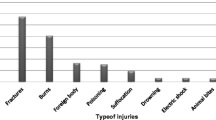Abstract
The objectives of this paper are to examine the extent of human injuries caused by Cyclone Sidr, which made landfall in Bangladesh coast on November 15, 2007, and report on the circumstances, type and causes of injuries, along with selected risk factors associated with such injuries. Relevant data was collected through a questionnaire survey administered among the cyclone victims. Semi-structured interviews with key personnel were also conducted to obtain information regarding the circumstances causing injuries and public response to care for the injured. The questionnaire survey data reveals that among the respondent families, 132 persons sustained various types of injuries. Since the respondent families comprised of 1,443 members, the injury rate was 9.15%. All injured victims were treated either onsite or in local hospitals. The most common types of injuries were soft-tissue injuries (cuts, bruises, and scrapes) and fracture/dislocations. The most common causes of injuries for survivors were associated with falling trees. Analysis of risk factors reveals that age is significantly correlated with injuries. Both formal and informal interviews suggest that injured persons and their family members were in general pleased with medical response they received from various sources. Several recommendations have been suggested to reduce future cyclone-related injuries in Bangladesh.


Similar content being viewed by others
References
Ahern M et al (2005) Global health impacts of floods: epidemiologic evidence. Epidemiol Rev 27:36–46
Ahsan RM, Khatun H (2004) Disaster and the silent gender: contemporary studies in geography. The Bangladesh Geographical Society, Dhaka
Ashley WS (2007) Spatial and temporal analysis of tornado fatalities in the United States. Weather Forecast 22:1880–2995
Bern C et al (1993) Risk factors for mortality in the Bangladesh cyclone of 1991. WHO Bull 71(1):73–78
Bertazzi PA (1989) Industrial disasters and epidemiology: a review of recent experiences. Scand J Work Environ Health 15(2):85–100
Borden KA, Cutter SL (2008) Spatial patterns of natural hazards mortality in the United States. Int J Health Geogr 7:64. doi:10.1186/1476-072X-7-64
BRAC (1991a) Cyclone ‘91: a study of shelter. BRAC, Dhaka
BRAC (1991b) Cyclone ‘91 alerts: what people knew and did. BRAC, Dhaka
BRAC (1991c) Cyclone ‘91: a study of semi-pucca structure. BRAC, Dhaka
BRAC (Bangladesh Rural Advancement Committee) (1991d) Cyclone ‘91: a study of epidemiology. BRAC, Dhaka
Brenner SA, Noji EK (1993) Risk factors for death or injuries in tornadoes: an epidemiologic approach. In: Church et al. (eds) The tornado: its structure, dynamics, prediction, and hazards. American Geophysical Monograph 79, pp 543–544
Brenner SA, Noji EK (1995) Tornado injuries related to housing in the Plainfield Tornado. Int J Epidemiol 24(3):133–151
Brown S et al (2002) Tornado-related deaths and injuries in Oklahoma due to the 3 May Tornadoes. Weather Forecast 17:343–353
Chowdhury AM et al (1993) The Bangladesh cyclone of 1991: why so many people died. Disasters 17(4):291–303. doi:10.1111/j.1467-7717.1993.tb00503.x
CPP (Cyclone Preparedness Program) and BDRCS (Bangladesh Red Crescent Society) (2007) CPP at a glance. CPP and BDRCS, Dhaka
GOB (Government of Bangladesh) (2008a) Cyclone Sidr in Bangladesh: damage, loss and needs assessment for disaster recovery and reconstruction. Dhaka
GOB (2008b) Super Cyclone Sidr 2007: impacts and strategies for interventions. Dhaka
Haque CE (1997) Atmospheric hazards preparedness in Bangladesh: a study of warning, adjustments and recovery from the April 1991 cyclone. Nat Hazards 16:181–202
Hasegawa K (2008) Features of super cyclone SIDR to hit Bangladesh in Nov., 07 and measures for disaster—from results of JSCE investigation. Foundation of River and Watershed Environment Managemen, Hokkaido
IFRC (International Federation of Red Cross), RCS (Red Crescent Society) (2008) Operation updates. Dhaka
Ikeda K (1995) Gender differences in human loss and vulnerability in natural disasters: a case study from Bangladesh. Indian J Gen Stud 2(2):171–193. doi:10.1177/097152159500200202
Jonkman SN, Kelman I (2005) An analysis of the causes and circumstances of flood disaster deaths. Disasters 29(1):75–97
Natural Hazards Observer (2008) Cyclone Sidr—Bangladesh. 32(3):4
Neumayer E, Plumper T (2007) The gendered nature of natural disasters: the impact of catastrophic events on the gender gap in life expectancy, 1981–2002. Ann As Am Geogr 97(3):551–566
Paul BK (2007) 2004 Tsunami relief efforts: an overview. Asian Profile 35(5):467–478
Paul BK (2009) Why relatively fewer people died? The case of Bangladesh’s Cyclone Sidr. Nat Hazards 50:289–304. doi:10.1007/s11069-008-9340-5
Pradhan EK et al (2007) Risk of flood-related mortality in Nepal. Disasters 31(1):57–70
Rofi A et al (2006) Tsunami mortality and displacement in Aceh province, Indonesia. Disasters 30(3):340–350
Shultz M et al (2005) Epidemiology of tropical cyclones: the dynamics of disaster, disease, and development. Epidemiol Rev 27:21–35
Sommer A, Mosley WH (1972) East Bengal cyclone of November 1970: epidemiological approach to disaster assessment. Lancet 299:1029–1036
Thacker MTF et al (2008) Overview of deaths associated with natural events, United States, 1979–2004. Disasters 32(2):303–315
The Daily Star (2007) Cyclone death toll now 3032. November 24
Tierney KJ et al (2001) Facing the unexpected: disaster preparedness and response in the USA. Joseph Henry Press, Washington, DC
WFP (World Food Program) (2007) Food security assessment: SIDR Cyclone—Bangladesh. New York, The United Nations
Acknowledgments
I wish to thank the Natural Hazards Center at the University Colorado-Boulder, CO; Dean’s Office, College of Arts and Sciences and Provost Office, Kansas State University, Manhattan, KS for funding this study. I also like to thank Munshi Khaledur Rahman and Bankim Rakhit for participating in the field survey in Bangladesh and Dr. Abdur Rob, Chairman of Bangladesh Red Crescent Society and Selvaratnam Sinnadurai, Head of Delegation of International Federation of Red Cross and Red Crescent Societies for their support in collecting relevant information for this study. Special thanks to the referees for their very helpful feedback and insights. For preparing a map for this paper, I gratefully acknowledge the assistance of Mitchel Stimers and Andrews Keela, both graduate students of geography at Kansas State University, Manhattan, KS 66506.
Author information
Authors and Affiliations
Corresponding author
Rights and permissions
About this article
Cite this article
Paul, B.K. Human injuries caused by Bangladesh’s cyclone sidr: an empirical study. Nat Hazards 54, 483–495 (2010). https://doi.org/10.1007/s11069-009-9480-2
Received:
Accepted:
Published:
Issue Date:
DOI: https://doi.org/10.1007/s11069-009-9480-2




